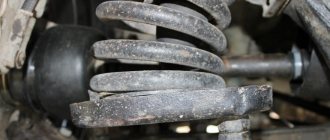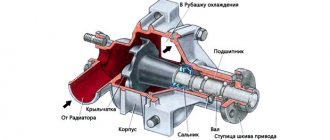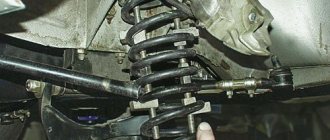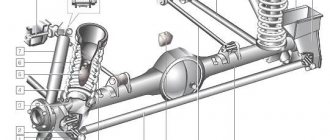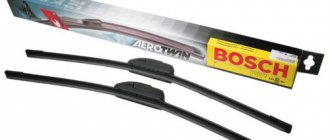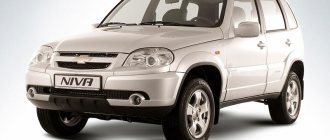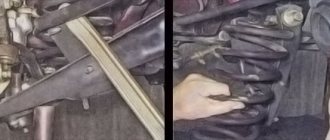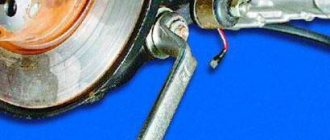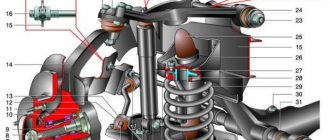December 23, 2015 Lada.Online 169 241 8
When using the car for a long time, you may notice that the body has sagged a few centimeters. This is a characteristic feature of wear on the suspension springs. Controllability and comfort depend on their rigidity. And if they are selected or installed incorrectly, then this is already a security threat.
Suspension lifting Niva VAZ 2121 21213 21214 2131
We will tell you how to properly perform tuning modifications in this material.
Do-it-yourself elevator - drawings, diagrams, sizes, types of kits. Lifting varies in the degree of intervention in the standard structure. For some, it is enough to raise the SUV by a few centimeters, and for others by as much as 20.
Extreme tuning – maximizing cross-country ability for traveling on severe off-road conditions.
- Regular jack
- Hijack jack
- Spring puller
- Balloon wrench
- Ratchet socket set
- Set of open-end wrenches
- Mount
- Wooden deck (stump)
It is advisable to perform such work with a partner. First of all, it's safer. Secondly, some lifting work is performed with four hands. Let's take the front suspension as an example.
Raise the front end. You can safely cling to the standard bumper, only the jack is installed under the pipe securing it. By removing the wheel, we get full access to the lever and spring. The front suspension 21214 is made using a double wishbone design, which simplifies the task.
The lever travel is limited by the shock absorber. Unscrew its fastening and move it to the side. Next you need to free the suspension from the anti-roll bar. The mounting bolts may become stuck due to corrosion, so we will use a penetrating liquid (such as WD-40). The stabilizer silent block clamp can be pryed off with a pry bar.
Then disconnect the hub from the lower arm. To do this, you need to jack up the suspension and fix the steering knuckle of the wheel. You can tie it with wire. Then unscrew the 3 mounting bolts and release the ball joint.
We fix the spring with ties and lower the jack. We remove the old elastic element. In some cases, it is enough to simply lower the lever with your foot, and the spring will come out without the use of ties.
Remove the upper support rings from the old springs. With their help, the elastic element is centered in the cups.
They come together easily with a hammer and screwdriver. We install the rings on new, longer springs. We put the elastic elements in their regular places and jack up the lower arm until it is completely aligned with the lower cup. At the same time, an assistant centers the shock absorber eye and moves the steering knuckle to the mounting location of the lower ball joint. We tighten the ball “triangle” and attach the shock absorber mounting axis.
By manipulating the jack, we “catch” the mounting holes for the stabilizer bar clamp. With its bolts it should get into the normal place without distortion. After such modernization, the clearance increases by 30-50 mm. This is enough to install wheels of larger diameter, and the bottom will still rise above the ground.
The rear axle of the Niva can be lifted by installing spacer supports of increased height. When using a size of up to 50 mm (according to changes in front end height), no modifications to the rear axle are required. By lifting the rear axle, maintenance can be carried out on the axle and brake system.
The handbrake cable may need to be replaced. It is lengthened by a couple of centimeters. Otherwise, the Niva lift will lead to increased wear of the brake pads in the rear drums. Disconnect the lower shock absorber mounts and lower them until the springs stretch.
We take out the elastic elements and knock off the support rings from them. We clean the upper cup and carry out anticorrosive treatment. We install new supports of increased size and seat the springs using a jack. We fasten the shock absorbers, assemble the axle, and mount the wheels.
Such a lift will not arouse suspicion among traffic police inspectors, and the cross-country ability of your NIVA 2121 will improve. No drawings, much less homemade parts, are required. You buy new springs and about the rates, the rest is a matter of technology. Labor costs for an elevator of one NIVA are two people/one day off.
For lovers of hunting, fishing and country travel, as well as those eager to try themselves and their own “Niva” in driving a vehicle in difficult-to-pass places, we have the opportunity to offer an increase in ground clearance, which increases the cross-country ability of your car.
Niva tuning – suspension lifting.
At the moment, there are at least 6 types of suspension lifting for Niva and Sh/Niva, each is interesting in its own right and is negotiated during the preparation of the car for “off-road” at the request of the visitor, taking into account the distinctive features of the operation of his car and the sizes of wheels and tires he uses wants to put it on his car.
Also interesting: Chassis, front suspension, device, Design, operation, description, device, car repair Niva VAZ 2121, engine, assembly, disassembly, transmissions, gearboxes
We often use a kit from the Russian club 'Korovka' as a base. This lift kit was made at the factory and was tested at competitions in Russia. The ground clearance increases by 5 centimeters, which actually makes it possible to install R15 235/75 or R16 235/70 tires (on the right wheels). In addition, this will provide a rise of another 4 centimeters.
In total, the increase in ground clearance will be 9-10 cm! In this version, “NIVA”, without loss of comfortable qualities, has the ability to be used both on paved highways and off-road, being in no way inferior to foreign-made SUVs.
Consequently, at the lower point of the RZM the clearance is 25 cm, and at the cut of the threshold - 44.5 cm.
Front suspension lift.
The lift is performed by installing targeted washers under the lower spring pad (they create a sufficient angle for the front spring). Under the upper arm (between it and the ball) another spacer washer is placed (i.e., we unload the arm).
The levers of the steering knuckles are swapped and the tips of the control rods already go from top to bottom (since subsequently the work done before, when the rod is fully turned, they will rest against the stabilizer, although at the request of the visitor it is possible to leave it as it was by changing the fastening of the stabilizer).
During lifting work, it is often necessary to change shock absorbers, springs, and resins on request. spacers, internal CV joint boots on tuning suspensions modified for this type of lift and create adjustments. spring bumpers.
Lifting the Niva suspension at the rear.
The lift is carried out by installing new rear spring cups, which are bolted on top of the standard ones, and brackets for moving the mounting points of the rear shock absorbers up 5 centimeters (bolted).
The short upper rods of the rear axle are lengthened or made adjustable (for easy rotation of the shank, so as not to bite the crosspiece), the reaction rods of the rear axle are either reinforced with an angle or installed double; at the request of the visitor, a rear axle stabilizer “Tehnomaster” (Tolyatti) is added, although it will be needed adjust to the elevator machine, digest.
Similarly, it is preferable, on lifted cars, to use a rear CV joint. Those who begin to lift old or worn-out cars need to remember about the internal CV joints (the balls leave their place) and will need to prepare for their replacement. The solution to this difficulty is quite possible by reducing the drive angle by untying the front axle.
The outer CV joints are too little susceptible to this, it will be worse for them if the wheel becomes larger in offset, width and weight, and then they can “crunch”. Although even then the hub bearing has a hard time, especially if it had play before.
Although we have avoided this problem, since we install steering knuckles with 2 ball bearings (from the rear axle shaft), they do not need to be adjusted; they are tightened all the way, although it is much better with a torque wrench. The unit comes out maintenance-free, the hub is unloaded, rolling is easier and the dynamics of the car are much better. Steering knuckles are naturally of domestic production and with a guarantee.
When installing wide wheels after a lift, you will need to keep in mind the ball ones (when the weak ones “fly”), the pendulum will also be able to fly, and the installation of the latest gas shock absorbers results in a stiffening of the upper bracket of the lane. shock absorber (otherwise it tears, especially when the front end is heavier), the mounting of the rear shock absorbers can also be strengthened. It is preferable when lifting, replace the suspension with p/urethane instead of rubber.
Economical Niva suspension lift of 1.5-2 centimeters. In such a situation, we resort to replacing the rubber spacers for the springs with tuning ones (of greater thickness), installing washers, spacers for the upper ball joints and adjusting the spring bumpers (at the visitor’s request). In this implementation, the Niva gets wheels (correct) in size R15 215/75.
The Chevy Niva bridge is held in place using five parts. To prevent longitudinal and transverse displacement, four longitudinal rods (two each: front and rear) and one transverse rod are used. At the ends of the products there are eyes into which silent blocks are inserted to prevent knocking in the suspension. One end of the rod is attached to the bridge, the other to the car body.
The parts have the same diameter and differ only in length. The longest is the transverse thrust. The length of the elements ensures vertical mobility of the rear axle. Thanks to this, the silent blocks do not twist, even if the suspension moves by the full stroke of the shock absorber.
Pneumatic springs for Niva Chevrolet.
Model Niva (Niva)
Size of factory springs for Niva Chevrolet without load.
Factory front spring size:
- length 315 mm
- outer diameter 120 mm
- rod thickness 15.8 mm
- internal diameter 88.4 mm
- load - up to 640 kg (with blue mark)
- greater than or equal to 640 kg (with brown mark)
Factory rear spring size:
- length 430 mm
- diameter 130 mm
- rod diameter 13.9 mm
- Inner diameter 102.2
- Working pressure from 0.1 to 1.5 atmospheres
- Minimum system pressure 0.1 atmosphere
- Pneumatic element size:
- Height 20 – 33 cm
- Diameter 8.5 - 14.5 cm
- Resistant to low temperatures, abrasives and reagents
Source material: 2006 shoe. with sagging soft (blue markings on the springs) springs front and rear, wheels - 2057515. In front, the distance from the top of the wheel bearing cap to the arch is 36 cm, at the rear - 42 cm, the levers in the center look down, the bumpers in the front springs practically lie on the cups .
In winter, when driving in the snow behind a fresh car, behind which there was only a track and an untouched middle, I cut everything off with my protection. Accordingly, on a hard surface I was constantly clinging to the protection and fighting with the levers. After the last competition, the rear left amm (Delfi) began to leak. The target model is to install tires in size 2357515 for not very sporty rides. Those.
The main purpose of operation is not city driving and quiet driving on dirt roads to the village or to the country, but driving every weekend over rough terrain in search of ambushes and ways to overcome them. It was decided because sagging springs - replace the springs, because Frequent off-road, near-sport driving was expected - install stiffer springs and ammas, make a lift for installing 235x wheels.
The lift option chosen was one with rubber spacers, and not, like Rybachok’s, a cup lift. This was due to the lack of a sane turner, the hassle of cutting off the stabilizer mount, and then digesting it, cutting out openings in the cup, touching the steering rods against the stabilizer mount, etc. Those.
This lift is NOT by lifting the cup, but by RUBBER SPACERS. As a result of the lift, we immediately got 45 cm from the top of the wheel bearing cap to the arch in front and 50 cm in the rear. Under the beam - 30 cm. After several iterations (reinforced spacers were removed from the rear springs) and two weeks of riding, incl. active along gullies - in front - 45 cm, behind - 45 cm, under the beam - 28 cm.
The CV joints don’t crunch, they don’t snag on the anthers, they don’t snag on the steering rods with the wheels up and turned out to the maximum, they don’t snag on the inner surfaces of the springs, they don’t dislodge front or rear brakes, up or down, and they don’t break brake hoses on the lift. I didn’t cut the bumper, although I had previously cut off the skirt on the front bumper.
Further operation will show what will happen next) This option is not an axiom, as was noted here on the forum - each car is individual, the described option was customized for my car, summarizing materials from the forum and the Internet. Some pictures are not mine, because... Either I didn’t take a photo of my own or it turned out crooked, all copyrights belong to their authors (and thanks for the ideas!), I’m attaching them here only for clarity. Thanks to Rybachok, Fangorn and others who posted here for ideas and visual solutions.
1. Front and rear springs*.2. Rubber spacers for springs with cups3. Front and rear shock absorbers*4. Spacers for upper ball joints5. Spacers (brackets) for rear shock absorbers.6. Washers for cup7. Extended bolts for upper ball joints8. Extended cup bolts
Also interesting: Chevrolet Niva instrument cluster tuning
* - new wheels are not required for the lift for 235e wheels
1.1 Front springs
From a search on the forum and the Internet, the following options for springs on the front of the car were found: - ShNiva (VAZ-2123) 2123-2902712: d=315mm; t=15.7mm (A-brown)—Volga Shtaer (GAZ-31105-600): 23-2902712, d=325mm; t=17mm—21st Volga: d=323mm; t=16.4mm—RAF: d=365mm; t = 17.3 mm In fact, it turns out that the spread in the length and thickness of the rod on the springs is different and varies quite freely.
It is also necessary to take into account that according to their stiffness, springs are divided into two groups - hard (A) and soft (B). Those. hard springs (group A - brown mark on the inside of the spring) with a load of 6276H (640 kgf) have a length of more than 192 mm; soft springs (group B - blue markings on the inside of the spring) at the specified load have a length equal to or less than 192 mm.
Apparently the consequence of this is that from stock there are immediately high shnivy (the distance from the top of the wheel bearing to the edge of the arch at the top is 42-44 cm) and there are low shnivy (the distance from the top of the wheel bearing to the edge of the arch at the top is 42-44 cm 39 cm). I will not consider such options as Tent, RAF, etc. because
It seems to me that these options are for other purposes (bigger tasks - a larger elevator) and their installation will be accompanied by a lot of trouble (searching for springs, their compliance with size and stiffness, issues of cutting springs, increased stiffness or length, etc.). It seemed to me (based on facts from the forum) that the original rigid Shniv front spring and enlarged (repair) rubber spacers would provide the necessary lift for 235 wheels.
As a result, a standard rigid spring was purchased (class A - brown mark on the inside of the spring) from a Chevrolet Niva with the following dimensions: d = 315mm; t=15.7mm.
1.2 Rear springs
d=465, t=13.7 (B-cherry). Those. we have the thickness of the rod equal to the standard one, but the length is 3 cm longer than the standard spring. Initially I planned and installed larger (repair) spacers with them, but practice has shown that the resulting length a) caused the rear of the car to bounce great on speed bumps (for example) b) the longitudinal rocking was quite strong.
Special spring ties will be very helpful in removing springs (see pictures below). Mine had to be modified with a grinder, but without them there would have been a whole problem in removing the springs.
In the general version of the lift for 235 wheels, if the springs are not sagging, replacing the springs front and rear is not required!
2. Rubber spacers for springs with cups
We purchased “rubber enlarged (repair) spacers for classic springs with metal cups.” Ask for this name in stores and car markets. Practice has shown that they are of different heights, the target model is the front - total height 4 cm, maximum height under the spring - 3.5 cm, rear - total height 5 cm, maximum height under the spring - 4.5 cm.
You need to take solid rubber bands, not corrugated ones - there is information that corrugated ones are squeezed out. Also, to prevent the rubber bands from being squeezed out, you need to buy metal shrink cups for them, as written above. In the elevator version with original Shniv springs in front and rear, rubber spacers are needed both forward and backward.
3. Front and rear shock absorbers
Because It was supposed to be quite active off-road driving. After the last competition, the rear left ammo leaked. According to information from the forum, the longitudinal swing on the standard ammos was quite large, it was decided to replace all the standing ammos (Delfi) with KYB. There are two series of ammos available for shnivy - soft (Premium, front - 444266, rear - 444267) and hard (Excel-G, front - 344441, rear - 344442).
Also interesting: Chevrolet Niva suspension: front, rear, device and tuning
In the general version of the lift for 235 wheels, if the springs are not sagging, replacement of the front and rear springs is not required. It seems like according to the forum they cope tolerably with the original shock absorbers.
4. Spacers for the upper ball joints
I ordered spacers for the upper ball joints from a turner according to the attached drawing. The forum recommended a thickness of 20-30mm, but I chose a compromise - 25mm. It’s better to drill with markings on the ball joint, otherwise they drilled it “by eye”, I had a glitch during installation - the ball spacers and holes in the upper arms did not fit together, then I had to drill out the holes from 8mm to 10mm.
5. Spacers (brackets) for rear shock absorbers.
The simplest solution here (according to the forum) is to weld additional ammo ears on top and bottom of the shock absorber. But because I have freshly purchased expensive kayaks and there is information that when the ears are normally attached to the body, they break off (the direction and angle of the loads), I did not dare to do such experiments and decided to make spacers for the shock absorbers.
The idea was taken here from Fangorn's forum based on his posted photos (thanks for the idea!). Their necessity is justified by the clarity in the pictures below - without spacers for the ammas, the downward stroke of the shock absorbers is more than enough, but there is practically no upward stroke of the shock absorbers - the consequence will be a thud when the ammas move upwards on bumps, which is confirmed by practice from the forum.
Thus, the proposed brackets lower the working stroke of the shock absorbers by 5 cm, shifting the upper limit of the rebound there. In addition, from the pictures it is clear that the standard location of the amma attachment to the body is not successful - under the applied loads, there is information that the ears of the shock absorbers are broken.
This issue seems to have been corrected during the restyling (later I checked during the restyling - no! The position of the upper ear mount is the same as on the pre-restyling!). Therefore, I turned the amma ear on the bracket 90 degrees - so that during normal movements it would not break off. At first I made the upper ear of the bracket from the cut off ear of the shock absorber (you can see it in the pictures), because
there was a problem with the turner. But practice has shown that due to the fact that in the house of attachment to the body a soft rubber bushing moved back and forth, and next to it there was a horizontal platform of the bracket - the whole thing mercilessly pounded this platform on the house on the body on bumps. It was decided not to be clever and made solid bushings, welded them, installed them, screwed them on and forgot about the problem.
Purpose
Chevrolet Niva comes from the factory with springs, both front and rear. The main purpose of these devices is to absorb all the shocks of the suspension that occur when the wheels hit potholes and bumps. They are located in the gap between the wheel and the frame of the car, due to which shocks from the road are smoothed out.
Also interesting: Chevrolet Niva error codes. Carrying out diagnostics.
For their manufacture, special high-strength steel is used. The number of turns of the device affects not only the quality of shock absorption, but also the distance of the body from the suspension.
This is important to know
Under no circumstances should the springs be replaced on just one side of the vehicle, even if one of the springs is in good condition. If the springs work differently, this will significantly reduce their service life and also lead to increased wear on other suspension parts.
The second thing you should pay attention to is the type of springs. There are two types of standard springs, which have different lengths for the same load. They can be distinguished by the color of the paint on the coils - it can be white or black. It is unacceptable to install two types of springs on a car - all springs must be of the same type so that the distribution of the car’s weight on the suspension is uniform.
Separately, we can say about reinforced or sports springs. If you decide to replace them, then change them on all four wheels at once. The length of the reinforced springs must be selected so that it matches the length of the standard springs. Only then will they work normally and give the desired effect.
The suspension of the Chevrolet Niva SUV is subjected to heavy loads when moving over rough terrain. A component of the suspension, the spring, is responsible for softening impacts and increasing comfort.
If during a trip the level of comfort begins to decrease, the car behaves worse in turns, then the elastic elements should be checked and replaced.
Types of breakdowns and their causes
The parts are made of high-strength alloy steel, so they are practically not subject to deformation.
The jet rod can only bend as a result of hitting large stones or tree stumps off-road.
More often, car owners have to deal with other problems:
- Cracks in the welds between the rod base and the eyes. If a breakdown is not detected in time, the part may fall apart while moving.
- Corrosion of rods. A rusted base loses strength and is easily deformed or broken.
- Wear and damage to rubber bushings of silent blocks. Over time, rubber dries out and cracks. This process is enhanced by physical activity. As a result, play appears in the connection of the rod with the bridge and the body. This worsens the car's directional stability and can lead to the lugs coming off.
Improved rear suspension
In this case, you will need a welding machine. When everything is ready, perform the following steps:
- Cups are placed under the springs
- We install a set of rear shock absorbers and attach the bracket by welding, as a result the rear axle will move slightly forward. To prevent this, it is advisable to lengthen all rods
- The lower cup is cut off and moved 3 centimeters. This must be done carefully, as the crosspiece may be damaged.
- We take the cups and weld them to a new place
- We lengthen the rocker arm of the brake system, as a result of which it should lengthen by 3 centimeters
- We weld fingers under the shock absorbers
The work can be considered completed.
After all the lifting work, you will need to install the main pairs, which will have completely different gear ratios, and if you had alloy wheels, they will need to be replaced with regular stampings. It is also advisable to purchase and install a self-locking differential on rear-wheel drive.
Which ones are better?
There are parts from several manufacturers on the market, among which the following options can be distinguished:
- Cross and Detal-Resurs are two budget brands that produce suspension parts for the Niva. Price - from 1600 rub. per set.
- Sitek - budget spare parts with rubber or polyurethane silent blocks. They are distinguished by their small wall thickness and low weight. Suitable for those whose route mainly runs on asphalt. Price - 2200 rub.
- Niva Urban - inexpensive high-quality spare parts for Niva Chevrolet. The manufacturer produces rods for the entire VAZ family. Price - 2600 rub.
- UG is another budget rod from a little-known company. Like Sitek, they are not intended for active off-road running. Price 3000 rub.
- SC is a more expensive model, characterized by a rectangular cross-section. Judging by the mass, the manufacturer did not spare the metal. The quality of the seam does not cause any complaints from car owners. Price - 3400 rub.
- Niva Extreme - reliable, durable suspension parts that are preferred by fans of extreme racing. The only drawback is the price, which is almost 5,000 rubles.
Types of springs
Standard elements can sag very quickly, and therefore the question may arise about which elements are best to install. There are more manufacturers on the market, but each car owner chooses for himself based on the price and quality of the product, so let’s look at a few of the most popular ones as an example:
- The manufacturer Izh-Techno is an excellent replacement for standard products; they have a longer service life, unlike their original ones. The price per set varies from 2800 to 3200 rubles. Therefore, if you do not want to overpay, this option is perfect for you.
- Manufactured by Kilen, they are produced in Sweden, so their price is quite high, the price of one element will be from one thousand to one and a half thousand rubles. The width of the coils, in contrast to the standard ones for which it is 13 millimeters, is 14 millimeters for the front and rear 14.9 millimeters.
- Manufactured by Lesjofors, it is practically an analogue of Klien, they even have the same number designations.
- Manufacturer Raid, they are the most popular and occupy a leading position. The production of these springs is carried out by three enterprises, painting is carried out by a Swiss complex, coiling is done on equipment from the USA, and the product is produced by a company from Russia. Having installed these springs, the SUV becomes completely unrecognizable, and every hole that comes along the way begins to be extinguished already in the initial stages. The price for two spare parts is about three thousand.
Compatibility of springs from Niva and Shniva
The time comes when the springs on a Chevrolet Niva need to be replaced. First you need to figure out which suspension elements are best to install so that they provide the expected properties.
The springs on the Chevrolet Niva from the regular Niva VAZ-2123 are not suitable. The reason for this is the differences in length. Let's consider the main technical parameters of these elements.
| Parameter name | VAZ-2121 Niva | VAZ-2123 Chevrolet Niva |
| Front | ||
| Bar diameter | 15.2 mm | 15.7 mm |
| Length | 278 mm | 313 mm |
| Rigidity | 74.42 kg/cm | 75 kg/cm |
| Load | 815 kg | 815 kg |
| Rear | ||
| Bar diameter | 13 mm | 13.9 mm |
| Length | 434 mm | 410 mm |
| Rigidity | 22.44 kg/cm | 30 kg/cm |
| Load | 483 kg | 483 kg |
From the comparison table it is clear that the free length of the parts in question does not correspond, which is the reason for the impossibility of installation, since the springs from the Niva are shorter.
What front suspension springs to install on a Chevrolet Niva
Model Niva (Niva)
The Chevrolet Niva car has a suspension that is specially designed for high mechanical loads. Therefore, all its elements have high strength. And in order to soften the shocks of the suspension, and so that while driving the impacts of the front suspension on the road surface are softened, it is equipped with special springs that play a shock-absorbing role.
If the standard models sag, cracks or various chips appear on them, or they are deformed, the front suspension spring must be replaced. Another common problem is deformation of the coil to the side; in this case, the problem can only be solved by a complete replacement. To make a replacement, you should prepare a standard set of tools and do the following:
- The SUV is placed on a jack and the wheel is removed from the side to be repaired.
- Using a wrench, unscrew the axle mounting nut at the lower arm
- Next, you need to remove the bolt that secures the shock absorber; this can be done by unscrewing the nut of the bolt located at the bottom of the shock absorber mount.
- At the stabilizer pad, unscrew a couple of nuts securing the bracket and remove the bracket
- We lift the suspension with a jack and shorten it so that the compression stroke limiter is released, after release, unscrew several bolts that secure the ball joint, and unscrew the bolts
- By lowering the jack, we slowly unload the suspension and remove the spring from the seat
- Remove the gaskets on top and bottom under the spring
- If necessary, you can remove the suspension compression stroke limiter
Also interesting: Tire size for a field, all-season tires for a 4×4 field, mud tires, the best winter tires for r16 wheels
You should know that the springs should be installed as a complete set at once, this is how you can achieve the full effect. If you install parts from different manufacturers, this will lead to a lack of necessary functioning, as well as to uncoordinated work. At first glance, this element may not seem as important as other elements in the car, but this is not so; they have quite a lot of value, especially among SUVs.
The Chevrolet Niva SUV is one of the vehicles whose suspension is subject to strong mechanical loads. Due to this information, each suspension element must have high strength properties. An element such as a front suspension spring is designed to soften the impact of the suspension on the road surface.
After all, as you know, this part, according to its purpose, performs a shock-absorbing role. But does the Chevrolet Niva have shock absorbers that are designed to soften the impact of the suspension on the road surface? – you say. Indeed, springs are an additional element of the suspension, without which the shock absorber simply would not last long. So, let's look at the topic of front springs for the Chevrolet Niva: what they are needed for, what they are and how to replace them.
Reinforced rods
The appearance of cracks between the rod base and the lugs will shorten the service life of the parts. This problem can even cause an accident - the car suddenly pulls to the side when the traction breaks.
To avoid unpleasant surprises, special reinforced parts are installed in the rear suspension. They are made of alloy or cold-rolled steel and differ from conventional ones in the diamond-shaped section of the base and powerful welding seams that hold the lugs.
Also interesting: Chevrolet Niva suspension diagnostics in Vladimir: addresses and phone numbers of car services, ratings and reviews, questions and answers
Reinforced rods differ from standard ones in the following characteristics:
- Reduced weight of parts.
- Improved paint coating that prevents corrosion of elements.
- High strength welded seams.
- Increased resistance to torsion, compression and tension.
Installation of reinforced rods is recommended for full use of the Chevrolet Niva off-road. They don't offer much benefit for city or highway driving. Under gentle operating conditions, the strength of standard rods is quite sufficient, so there is no point in overpaying for reinforced parts.
Characteristics of suspension springs for VAZ cars
You can find out the price of a part by the catalog number (article), which is indicated in the tables.
Front suspension:
Rear suspension:
1 Before coating. 2 Dimensions and parameters for reference. 3 Including control washers. 4 DP - existing production; PP - production preparation; ZCh - spare parts; OV - extended turn; n.d. - no data.
Complete video instructions for replacing jet rods on a Shnivy
The work is carried out on an overpass or inspection ditch. To replace jet rods you need to prepare:
- hammer;
- a pair of spanners 19;
- metal brush for cleaning threads;
- mounting blade;
- WD-40 liquid.
Reaction rods need to be changed in the following sequence: transverse, front, rear. You should not lift the rear axle with a jack, otherwise there will be difficulties in aligning the holes of the silent blocks and mounting brackets.
Work order:
- Clean threaded connections with a wire brush and spray with WD-40.
- Unscrew the lower mounting nut and move the shock absorber to the side so that it does not obstruct access to the transverse link nut.
- Unscrew the threaded connections holding the silent blocks and remove the transverse rod.
- Install a new rod and screw it on the top side.
- Align the holes in the silent block and the bracket, insert the bolt and tighten the nut.
- Unscrew the fasteners, remove the front rod and replace it with a new one.
- Repeat the previous step for the remaining front and two rear links.
If the rods have not rusted or bent, or cracks have not appeared on them in the area of the welds, you can only get by by replacing the rubber-metal bushings. In this case, you can save on buying new rods and get by only with silent blocks.
To replace the bushings you will need a vice, a thick screwdriver, a pair of tubes and a special tool for pressing. The diameter of the first tube is 60-80 mm. The thickness of the second should correspond to the diameter of the metal bushing of the silent block.
The pressing device is a metal rod, the thickness of which is slightly less than the inner diameter of the rubber part of the silent block.
There is a thickening on the rod that presses on the rubber bushing. The diameter of the thickening must correspond to the outer diameter of the silent block.
Replacement of bushings is carried out on removed rods.
You need to start by dismantling the old silent blocks. Press the tubes on both sides into the hinge: the thin one into the metal bushing, and the thick one into the rubber bushing. Clamp the structure in a vice and tighten it. The metal bushing will come out of the silent block and the rubber will be easy to remove from the eye using a thick screwdriver.
Before installing a new silent block, it is necessary to clean the inner surface of the eyelet and lubricate it with a solution of soap or detergent. Oil, which is recommended for use in some assembly instructions, will shorten the life of rubber bushings.
After this, all that remains is to insert the pressing device into the rubber bushing of the hinge, lean it against the eye of the rod and compress the structure in a vice.
The metal sleeve is pressed in with the same device. To facilitate installation, it must be treated with a soap solution.
Replacing silent blocks alone takes more time than replacing the assembled jet rods. However, if the condition of the rods is satisfactory, you can leave the old ones. In the absence of extreme loads, they can travel 100 thousand kilometers or more.
How to lift a Niva yourself
If you want to do the Niva lift yourself, then take this procedure very seriously, since despite the simplicity of the work, the slightest mistake will result in irreversible consequences in the future. Therefore, no matter what the car becomes unusable for use, you must strictly follow all the rules, and if there are any doubts, then it is better to turn to a professional.
In order to carry out all the work, it is enough to buy a ready-made lift kit, but there are car owners who upgrade the parts themselves, if you are one of them, then you need to stock up on the following parts:
- Set of springs
- Rubber spacers for springs with steel cups
- Shock absorber kit
- Special spacers for ball joints, the thickness of which should be approximately 30 millimeters
- Make a special mount for the rear shock absorbers
- There are twelve spacer washers under the cup with the following dimensions:
- For cups and long ball bolts
- Two jacks and a spring tie
You also need to additionally make special spacers for the rear shock absorbers. They can be made from corners, and bushings whose thickness should be approximately 32 millimeters are welded to them.
DIY replacement
Replacement of rear and front springs is carried out not only when they sag, but also when chips, cracks, and other defects are detected. At the initial stage of work, the necessary tools and materials are prepared.
Read news about the new Niva
- Chevrolet Niva suspension: front, rear, device and tuning
- Suspension lift in the field yourself
- What is the difference between Niva Urban and regular Niva?
- The modernized Lada Niva Legend (4x4) 2021 was shown on the Internet
- Lada 4×4 Bronto - sales stopped, new details » Lada.Online - all the most interesting and useful about LADA cars
- Description of the instrument panel Lada 4×4 (VAZ 2121, 2131) » Lada.Online - all the most interesting and useful about LADA cars
- Chevrolet Niva gasoline consumption per 100 km
- Buy LADA (VAZ) 2131 (4×4) 2021 in Rostov-on-Don, low price for Lada 2131 (4×4) 2021 on the Avto.ru website
see also
Comments 16
I would take the rod and measure it. They are 0.3mm thicker and half a cm longer.
Actually, I measured it one to one!
What did he put on the bronto in return?
The springs are from BMW, and the engine is from BMW, and the gearbox...))
I see, black Bronto 2.0 diesel)))
I came to the conclusion that now (they say it was different before) on the Lynx the M-Con springs remain from the factory...
There are also three types of shniva springs: hard with a brown mark, soft with a blue mark, and soft with a yellow mark, in between the first two)
Read more: Replacing antifreeze on Kia Seed
I heard about this, but in reality you will find figs with different labels))
I was running around with shock absorbers for a friend who is also an Emka. There are their own and only 21214 M.
I don’t know about the front ones, because I haven’t changed them, they still stand the same as the original ones, and the rear ones on the Mka are from the Chevy. It says 2123 on them
about the shock absorbers on the 21214M, this is what an AvtoVAZ representative answered on niva4x4.ru: “Why are there new shock absorbers on the 21214M, and not 2121 or 2123? The reasons are as follows:
1. I wanted to obtain optimal characteristics of the shock absorber at the highest possible temperature range of their operation. Simply put, so that the shock absorber, firstly, overheats less and, secondly, at high temperatures maintains its characteristics for as long as possible. Experiments have shown that it is easier to achieve this on dimensions 2123 than on 2121 (which is why they are not 2121).
2. Initially, it was planned to completely unify the shock absorbers 2123 and 21214, but due to the layout, as well as considerations that the price of the new shock absorbers 21214 and 2123 are not significantly different, it was accepted that the shock absorbers would be original (therefore they are not 2123).
3. The rear shock absorber 21214 differs from 2123 only in length. This was done in order to increase the life of the shock absorber and reduce the likelihood of body damage due to suspension breakdowns. Because If the 2123 shock absorber is longer, then if the rear suspension on the 21214M breaks down, it acts as a compression stroke limiter, which can lead to its premature wear and destruction. The front shock absorber differs in characteristics and strokes. When installing the front shock absorber 2123 on the 21214M, the upper shock absorber bracket on the body may be destroyed, because The 2123 shock absorber is longer and during breakdowns and dynamic compression strokes, the entire load will fall on the top point of the shock absorber. In addition, according to the characteristics of the 2123 shock absorber, it will cause the front axle to “float” on uneven roads and soils, and the car will tend to yaw and sway.
I won’t argue, but all these calculations are for a stock car) although it’s not a big one, I have a suspension lift, so 2123 shock absorbers are needed back and forth, since it’s longer)
Thank you! Useful article since I have a Niva M.
Well, I decided to get confused and compare everything, since I didn’t find any information, but it was interesting)
Because You are not logged in. To come in.
Because you are not a trusted user (phone number is not verified). Enter and confirm your phone number. Read more about trusts.
Because The topic is archived.
There are a lot of theorists on the forums who, without technical education, are trying to come up with their own theory, and the worst thing is that they believe in it and try to impose it on everyone.
Read more: Setting up a Nissan laptop radio
If you want to see live how everything is implanted, come, I’ll show you and tell you everything. The strokes of the original shock absorbers are enough! ¶
Speak for yourself and for yourself. I am surprised by theorists who have no experience at all.
If you want to ask me about the rigidity that has become, then I will answer you: it has become a little tougher than the standard, but I don’t think that anyone will be able to distinguish the rigidity unless you tell them. Volga springs perform very well at large amplitudes of work: driving at speed bumps, driving over rough terrain at high speed, etc. ¶
The suspension of the Chevrolet Niva SUV is subjected to heavy loads when moving over rough terrain. A component of the suspension, the spring, is responsible for softening impacts and increasing comfort.
If during a trip the level of comfort begins to decrease, the car behaves worse in turns, then the elastic elements should be checked and replaced.
Video
We recommend watching detailed video instructions, this can save you time and effort when carrying out repairs on your own
Hello everyone) I finally got around to writing a post about how the front springs were replaced in my car. In principle, I did everything according to the experience of those who wrote their posts on the forum about the replacement, but I had to change a little and add my own, well, in general, in order... my front springs sank so much that I felt all the bumps and rode on the bump stop. It was decided to buy and replace the front springs as in the photo
and naturally pullers were needed to remove/insert the springs. there was an opportunity to buy for 350 rubles. new, but I think why buy for one time when a friend has it.
In general, I began to change it: I jacked up the car, took off the wheel, and put blocks under the lever so that I could then put the car on them. I unscrewed the ball joint, the stabilizer and... did something that none of the people I read on the forum did... I unscrewed the shock absorber. This caused the lower arm to fall completely and the springs to fly out. It was easier to insert since you held it with your hands and lifted the lever with a jack, the spring fell into place and the pullers flew off, this is what happened after replacement
